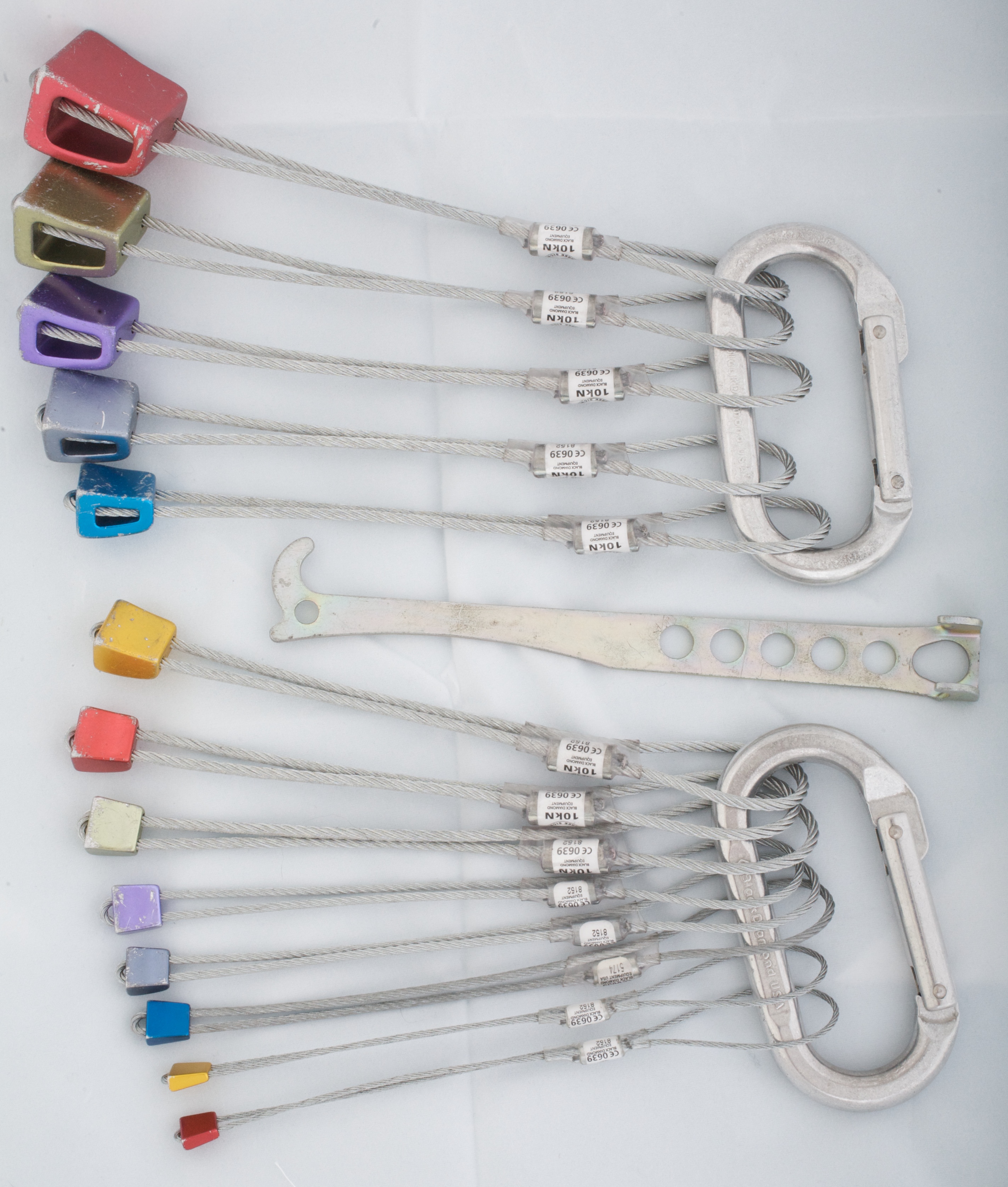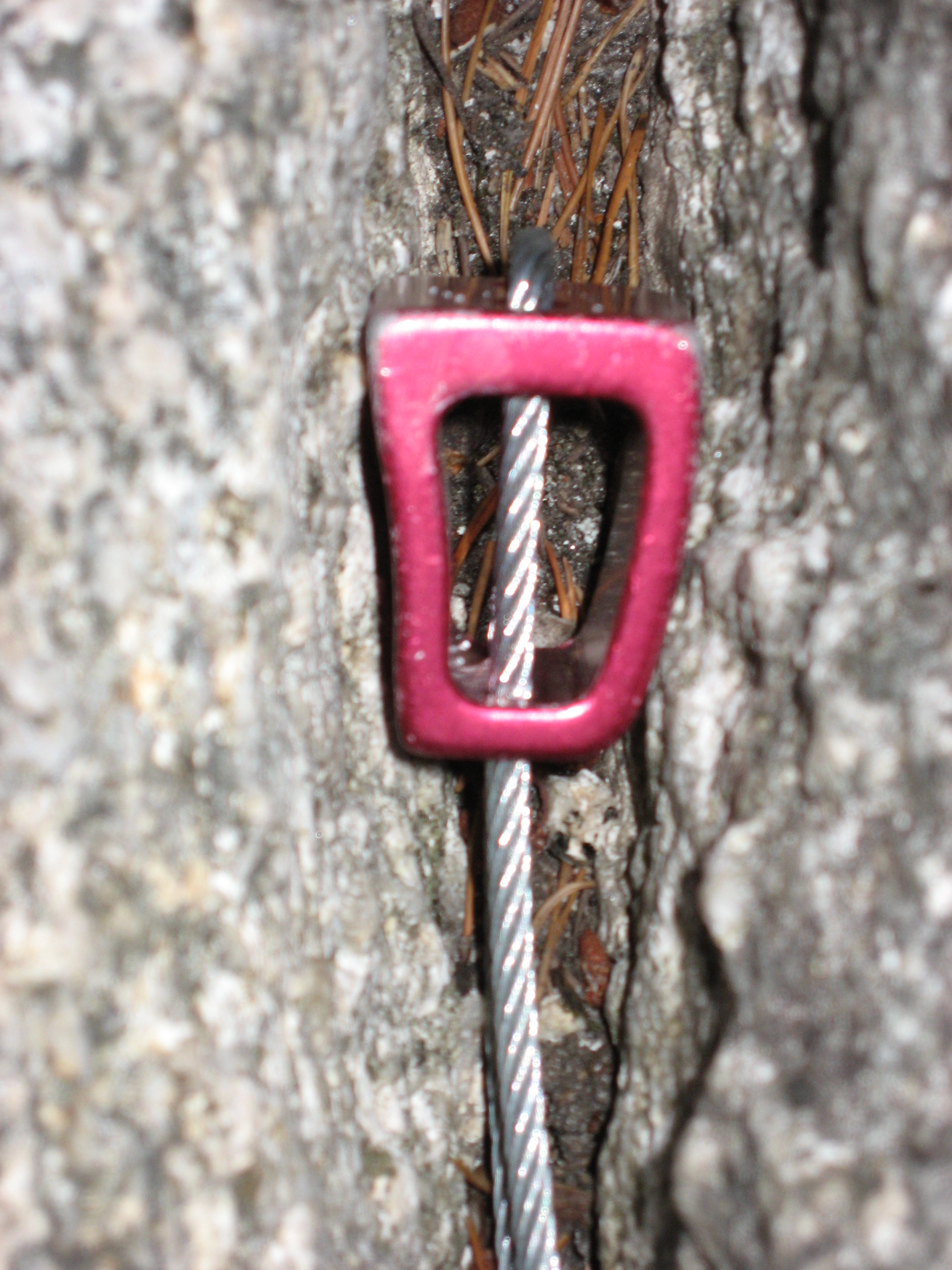Nut (climbing) on:
[Wikipedia]
[Google]
[Amazon]
 In
In  By 1967 Royal Robbins saw the need for clean climbing and put up Nutcracker, an all nut protected 6 pitch climb, on the Manure Pile (Ranger Rock), Yosemite. In 1972, when clean climbing became an issue in the US,
By 1967 Royal Robbins saw the need for clean climbing and put up Nutcracker, an all nut protected 6 pitch climb, on the Manure Pile (Ranger Rock), Yosemite. In 1972, when clean climbing became an issue in the US,
 In
In rock climbing
Rock climbing is a climbing sports discipline that involves ascending climbing routes, routes consisting of natural rock in an outdoor environment, or on artificial resin climbing walls in a mostly indoor environment. Routes are documented in c ...
, a nut (or ''chock'' or ''chockstone'' or wire for the smallest versions) is a metal wedge threaded on a wire that climbers use for protection by wedging it into a crack in the rock. Quickdraws are clipped to the nut wire by the ascending climber and the rope threads through the quickdraw. Nuts come in a variety of sizes and styles, and several different brands are made by competing manufacturers. Most nuts are made of aluminum
Aluminium (or aluminum in North American English) is a chemical element; it has chemical symbol, symbol Al and atomic number 13. It has a density lower than that of other common metals, about one-third that of steel. Aluminium has ...
. Larger nuts may be threaded on Dyneema cord instead of wire, but this has become unusual.
The very smallest nuts are known as ''micronuts'' and may be made of brass
Brass is an alloy of copper and zinc, in proportions which can be varied to achieve different colours and mechanical, electrical, acoustic and chemical properties, but copper typically has the larger proportion, generally copper and zinc. I ...
or other metal, and typically have their wires solder
Solder (; North American English, NA: ) is a fusible alloy, fusible metal alloy used to create a permanent bond between metal workpieces. Solder is melted in order to wet the parts of the joint, where it adheres to and connects the pieces aft ...
ed into them, instead of looped through drilled holes. They are mostly used in aid climbing
Aid climbing is a form of rock climbing that uses mechanical devices and equipment, such as aiders (or ladders), for upward momentum. Aid climbing is contrasted with free climbing (in both its traditional or sport free climbing formats), whi ...
, and their value as protection, arresting a climber's fall, is marginal because of both their low breaking strength and their tiny surface area (the HB 0 measures about 4 x 7 x 2.5 mm) in contact with the rock, though this can be offset if several are placed at a time. Other names used include ''RPs'' (the brand name of the first commercially available micronuts) and ''brassies''. They are available from several manufacturers in a variety of styles.
British climbers in the 1950s and 1960s were the first to use nuts as climbing protection. In addition to using pitons, they picked up machine nuts from the side of railway tracks, climbed with them in their pockets, and used them as artificial chocks. This developed to the point where they drilled the thread from the middle, threaded them with slings, and used them in cracks.
Nuts or chockstones are named after natural stones occasionally found wedged into cracks. Climbers eventually realized they could insert their own found pebble into a suitable crack. In an article called "Artificial Aids in Mountaineering" dated Oct-Dec 1956, G Sutton wrote about jammed knots for direct aid. He also compared the use of slings, chocks (rocks) and jammed knots to artificial climbing (aid climbing) and that "there should be no illusion that the use of a chockstone is in any way more admirable than that of a piton."
 By 1967 Royal Robbins saw the need for clean climbing and put up Nutcracker, an all nut protected 6 pitch climb, on the Manure Pile (Ranger Rock), Yosemite. In 1972, when clean climbing became an issue in the US,
By 1967 Royal Robbins saw the need for clean climbing and put up Nutcracker, an all nut protected 6 pitch climb, on the Manure Pile (Ranger Rock), Yosemite. In 1972, when clean climbing became an issue in the US, Yvon Chouinard
Yvon Chouinard (born November 9, 1938) is an American rock climber, environmentalist, and businessman. His company, Patagonia, sells outdoor products, outerwear, and food. He was named one of the 100 most influential people in the world by '' ...
began manufacturing chocks made specifically for rock climbing, with the familiar wedge shape still in use today. With Tom Frost, Chouinard invented a larger, six-sided nut called a Hexentric or hex. Prominent climbers like Henry Barber and John Stannard helped popularize the use of nuts, especially after it was discovered that a nut was lighter and easier to place and remove while climbing, as well as being at least as secure as a well-placed piton, and less damaging to the rock.
Nuts are available in different shapes to help the climber find the best fit for a given crack. Curved nuts have a concave face on one side and a convex face on the other. Larger nuts can be placed in either of two aspects (hexes in three aspects) to suit different-width cracks, with either the main faces or the sides in contact with the rock.
Nuts may be generically referred to as ''wires'' or ''stoppers'', though "Stopper" is a brand name of a nut made by Black Diamond Equipment.
References
{{Climbing-nav Nuts Mountaineering equipment